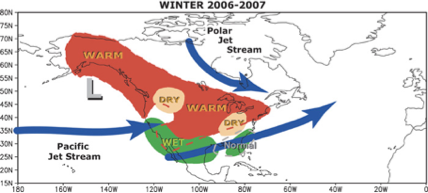This poor child is being blamed for practically everything from lost socks to Barbara Streisand not winning an Oscar. A Boston Globe columnist accused El Niño for having “strange effects” on Massachusetts politics. This powerful ocean event has been linked with the warmest winter ever recorded in northeastern United States and with Denver, Colorado, suffering record snow falls. El Niño has brought both good and bad weather patterns to regions around the world. Scientist claim that El Niño brings drought to southeastern Asia and Australia, out-of-control wild fires in the Amazon rain forest, massive floods in China, more hurricanes in the Pacific Ocean and fewer hurricanes in the Atlantic.
Exactly what is El Niño? We are told that every two to seven years, a large pool of warm water builds up in the Pacific Ocean along the equator. This warm water heats the air above it, affecting the air pressure, the sea level, and the winds that blow across the Pacific. The blowing trade winds trap warm pools of ocean water along the coast of Australia and Indonesia. During El Niño, however, these trade winds relax and the warm pool flows eastward toward Ecuador and Peru. Fishermen off the west coast of Ecuador gave these warm currents of water around Christmastime the name El Niño – Spanish for small boy or the Christ Child. It was the signal for the beginning of the fishing season.
The ocean temperature along South America rises from one to four degrees. This warm water then heats the air, which can then hold more moisture. As you would guess, these changes in water and air temperatures have a dramatic effect on the weather. El Niño itself does not create rain or snow, ice or drought. It merely sets the stage for unusual weather to occur. During the 1920s, scientist recognized that this warm water also affected weather patterns world-wide and adopted the Spanish name to describe this large-scale event.
Since 1900, El Niño has occurred 23 times. Usually, it appears in December to March and stays around from 12 to 18 months before disappearing. The latest El Niño has been around a much longer time causing the past two winters to be unseasonably warm. El Niño has a twin sister call La Niña, meaning “the little girl,” which brings cold water to the cost of South America. La Niña disrupts the jet stream and leads to the extreme weather patterns with the result that droughts turn to heavy rains, balmy winters are followed by record-breaking snowfalls, and hurricanes and tornadoes form along the Gulf Coast and the Atlantic.

Here is what is happening as we speak. The NOAA National Centers for Environmental Prediction Climate Forecast System, show El Niño conditions peaking during the northern hemisphere winter (December 2006 through February 2007) and then weakening during the northern hemisphere spring (March through May 2007).
